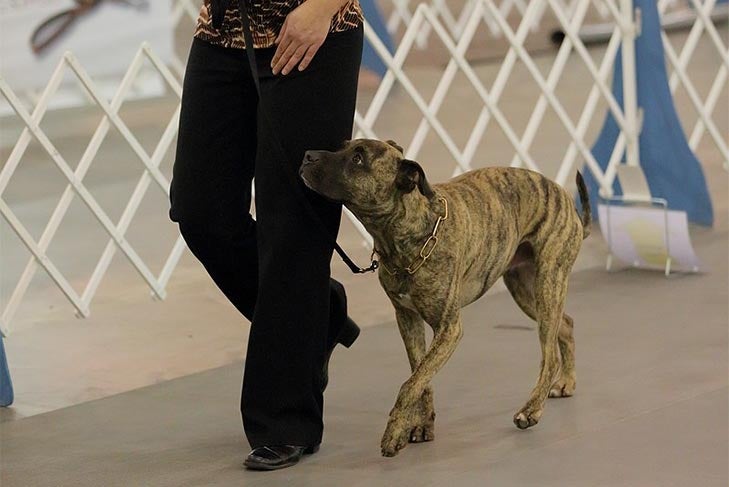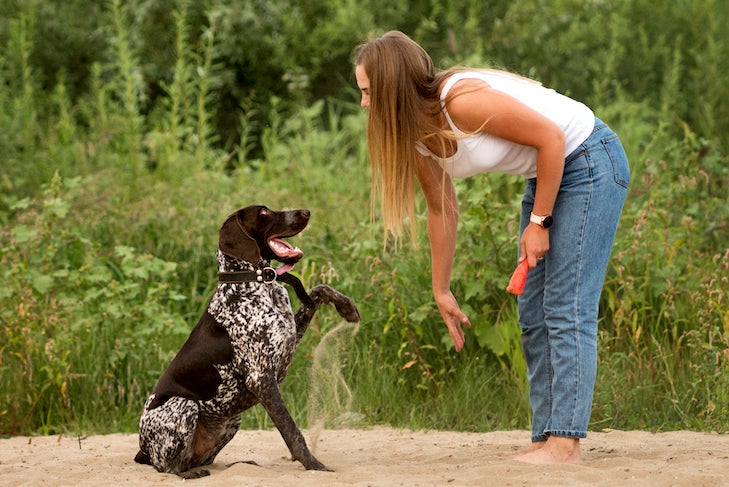Many dogs enjoy training and participating in dog sports, but your pet might like some activities more than others. So how can you tell if your dog is having fun with dog sports?
The more time you spend with your dog, the easier it will be to interpret and understand their reactions and attitudes. Here are some considerations to keep in mind as you determine whether your dog is enjoying themselves, or if something else might be better for them.
Watch Their Body Language
Dogs communicate most clearly with their body language. Study how your dog reacts in different circumstances. These reactions will help you identify how they behave when happy or anxious. This can help you assess if a training session is going well or if they’re enjoying a sport.
Signs of stress include raised hackles (meaning the hair on their back stands up), yawning, licking their lips, tucking their tail, pressing their ears against their head, avoiding eye contact, and panting (when they haven’t exerted themselves physically and when it’s not hot outside). If your dog runs off to sniff while training, that can also indicate that your dog is anxious. Sniffing is a self-soothing activity dogs engage in to try to self-regulate and calm themselves down.

When training, we want to see a dog displaying body language that is relaxed and confident. Signs of a calm and confident dog include:
- Holding the tail up or in a neutral position. The exact position may depend on the breed
- “Soft” eyes. When the eyelids are relaxed, sometimes it will look like the dog is squinting
- Wagging the tail in a slow, side-to-side motion
If your dog displays body language indicating they are uncomfortable, consider talking them out for a walk to get a little break before continuing. Try keeping training sessions short and playful, keeping an upbeat attitude, to encourage your dog to enjoy training time. Regardless of what sports you’re involved in, try to stop a training session after your dog has successfully completed a task. It is best to end a session when your dog is still engaged and not tired. Ending a session this way leaves your dog feeling confident and wanting to do more.
Increase Difficulty Levels Slowly
Participating in dog sports can help build your dog’s confidence. We want our dogs to gain confidence by slowly increasing the difficulty level of the skills we ask them to perform. Experiencing too much stress at once can cause your dog to freeze and emotionally shut down, feel afraid, or become disinterested in training. They may also try to get away from an exercise, or you may have to convince or bribe them with treats to participate, which isn’t good for training.
Start out by introducing your dog to low amounts of potential stressors. For example, if you’re introducing your dog to jumps for Agility, start out with the jumps at a low height (rather than full height, which might be intimidating). Once your dog has become comfortable working with those jumps, then you can raise the height.
Consider Your Dog’s Health
Before getting involved in dog sports, always bring your dog to their veterinarian for a full health check. If you’re actively training and competing and your dog continually seems disinterested, bring them in for a checkup to make sure that they’re not experiencing any pain.

If your dog regularly jumps while participating in Agility, Obedience, or AKC Rally, their feet or legs may sometimes knock into the bars of the jump. But if that starts to happen more than usual, ask your vet if there could be an underlying medical condition impacting performance. Once your dog has recovered from an injury, you may want to explore participating in a lower-impact sport, like AKC Scent Work.
As your dog ages, discuss your pet’s needs with your vet. Ask them if it’s still appropriate for your dog to participate in higher-impact sports like Fast CAT. If your dog has experienced repeated injuries in a sport, you may need to consider whether or not it’s in your pet’s best interest to continue to play that sport.
Environmental Stressors
A dog’s perspective on a sport may shift depending on where they are training. In particular, environmental stressors, like echoes in large, empty buildings or the sound of collapsing equipment, might scare a dog.
Dogs who are shy or sound-sensitive may struggle to compete at large venues with multiple rings of competition and lots of dogs or people. Instead, they may have more fun if their owners enter smaller shows with fewer people and dogs around. Similarly, dogs who are nervous or become overly excited by other dogs may do better competing at smaller shows. They may also prefer to participate in sports like AKC Trick Dog, AKC Scent Work, or Obedience, where dogs aren’t moving as quickly or barking as much as in sports like Agility or Flyball.
If your dog gets overwhelmed by noise, try practicing in quiet areas with fewer distractions first. Once your dog is engaged and calm in this environment, slowly transition to practicing in more distracting areas, increasing the rate of reinforcement (how often you give rewards).
What if They Just Don’t Like the Sport?

Even if your dog gains all the skills necessary to successfully compete in a particular sport, they may not enjoy participating in it. If your dog appears to be going through the motions but isn’t their normally enthusiastic self, consider taking a break or trying a different sport. For example, the AKC FIT DOG program can be a fun way for humans and dogs to get moving together. You might be surprised to see your dog’s sluggish performance in one sport turns into enthusiastic engagement with another event.

